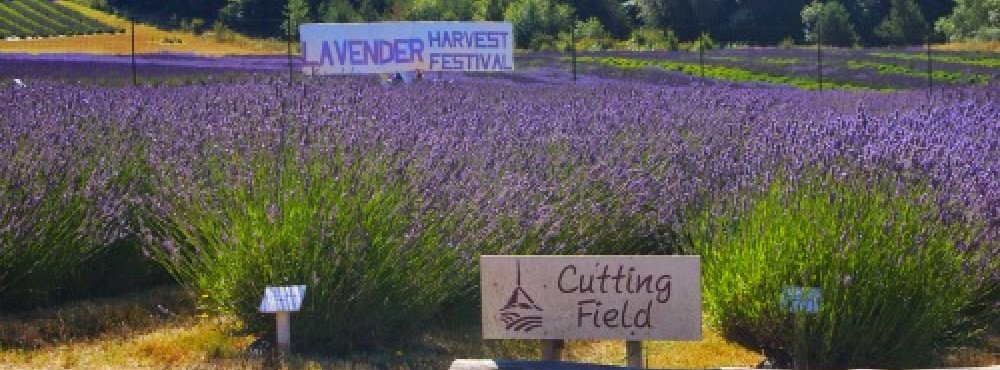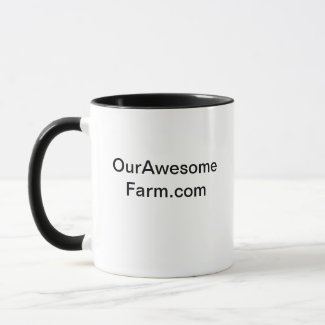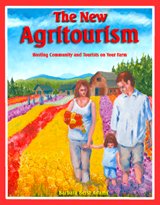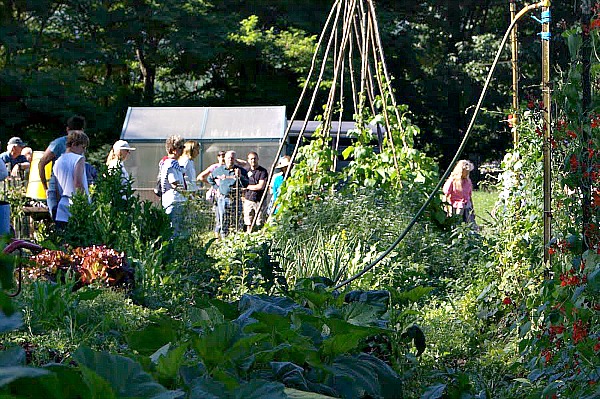
© National Lilac Publishing. A version of this article was first published in AcresUSA Magazine.
Easing into Agritourism: Slow and small may be the farm owners’ best route
Adding an agritourism element to a farming operation can be tempting for some. Possible experiences for your visitors include education about farming such as sheep shearing demonstrations; entertaining activities like gourd painting classes, or simply the opportunity to observe the crops and animals on a working farm.
Visitors range from the local community to out-of-country tourists. When non-farming citizens come directly onto the farm enticed by the possibility of enjoyable experiences, the farmer can benefit in multiple ways. In some cases, farm owners use agritourism as a marketing platform to draw customers to the farm to buy and pay for the farm’s crops directly, eliminating both the need to deliver crops as well as the middleman’s cut.
As well, the agritourism itself can add direct revenue by charging a fee for workshops or tours. And though this could be anything from a one-hour herb drying class at a backyard herb market garden to overnight rural B&B stays, here’s one example of revenue from the well-known October pumpkin agritourism niche.
It’s described here by Jane Eckert, founder of Eckert AgriMarketing. “While the average pumpkin sale might be $4 -- $8 per customer, they will generally spend at least $20 per family just to have a fun day on the farm. Fall season revenues might start for farms at just a few thousand dollars. But with a little bit of ingenuity, hard work and a good product mix, $100,000 is not a difficult goal for a farm to reach in October. After several years, many farms are approaching sales up to $500,000 and more. Most farms I know exceed $100,000 annually from their October season. The concept is to start small with pumpkins and then start adding the products, food sales, school tours, etc., and the revenue quickly builds.”
But the farmer gains even more subtle benefits when agritourism is operated successfully. For example, they get direct customer comments and feedback -- something corporations call marketing research. It can be extremely valuable for an herb farmer to find out a customer’s cousin is opening a new organic Italian restaurant in town and wants to buy local and direct. Overhearing multiple customers rave about the new heirloom cucumber variety from the market farmer’s test plot can let her know it will be a popular crop to expand upon next season.
On-farm events are a great way to both gain and keep current CSA (community supported agriculture) customers. Agritourism can also help with products sold off-farm even if agritourists don’t buy directly from the farm during their visits. When the owner of Skagit River Ranch in Washington State led farm visitors on a tour of his ranch, they were stunned at how and why he offered life-giving humic acid to his free-range laying hens and how cleanly yet naturally he fed his hogs which were enjoying the sunshine in their outdoor pen. Plus, people on the farm tour were genuinely appreciative of him taking time out of his busy life to show them what goes on behind the scenes. From then on, at every food co-op or restaurant those people went to that offered the ranch’s products, their name stood out prominently. People made comments in stores and restaurants to other people about how much they preferred the Skagit River Ranch products over any others.
But the idea of bringing large-scale agritourism to the farm can be daunting as well.
Do farmers really want to manage ongoing crowds, install parking areas, haul in portable toilets? How about putting up signs, extra fencing and locks on gates to keep kids out of ponds and keep sheep inside pastures? What if a huge investment in agritourism was made, only to find out customers weren’t as interested as was initially projected? What if it turns out working with people is a lot more draining and difficult than originally thought?
Luckily with agritourism, there isn’t just a choice between nothing at all or becoming a rural edu-tainment mecca. Agritourism can be small, slow and gentle and remain that way, or at least start that way before jumping into a larger project. Even just a one-time afternoon event can still brings benefits to the farmer.
One summer, the Slow Food convivium of Skagit County, Washington State, connected with the owner of nearby Willowrose Bay Orchard. Willowrose grows rare quince trees, aronia berries, and produces and sells a variety of products from those fruits. The Slow Food movement is a worldwide organization dedicated to rediscovering rare and traditional crops and food-processing methods. They have what they call local conviviums for Slow Food members to hold cooking and tasting events and tour local farms.
The benefits of pre-formed groups:
This particular Slow Food group was always on the lookout for local sustainable farms and field trips for its members. They worked out a deal to arrange an afternoon tour of the farm for any of their local members who might be interested. The leader of the Slow Food group at the time solicited interested folks who wanted to tour the farm. She gave them directions to the farm, arranged carpools to get them there, and asked them for at least a $10 per person donation to go towards the farmers’ time. About a dozen people showed up to learn about quince, how it grows, and how to cook with it. The farmer didn’t have to do any promotion to generate farm tourists, nor do any crowd management. She received a cash donation for her time, she got valuable customer feedback, and the farm’s product and brand stood out to those tourists from then on.
When farmers invite groups that are already formed in some way -- such as 10 members of a long-standing garden club or 15 members of an established book group -- there’s already a working synergy to the group that’s often missing when inviting the same number of the general public. It’s usually far easier to deal with an already established group than a random group from the public.
On a similar note when inviting kids to the farm, an elementary classroom that shows up in spring after the students have bonded as a group and with a teacher they’re accustomed to listening to is far different than letting 30 kids from the general public be dropped off at the farm. Even if their parents are also invited -- as described below concerning a horse rancher’s near disaster -- there can be a lot more surprise crowd control needed than if a pre-formed group with an established leader -- such as the teacher -- shows up. Scout troupes and kids’ church groups would no doubt also fall into the category.
Even with such groups, crowd control and management issues will show up, but usually not quite as many. When one classroom of 5th graders we observed took a field trip to a farm, one of the farm hands was delighted to be given the job of answering their questions and showing them around. It can be very rewarding to share what you know. However, the kids were quite fascinated with the fact that sometimes people have died from falling off tractors. The farm hand showed them the various safety measures in place. For example, how roll bars worked and how a person learns to properly land and roll away if he does fall. Under the watchful eye of the attentive teacher, the kids respectfully raised their hands before asking him questions about these safety measures and about what could go wrong. After about ten minutes of him surrounded by intent, serious, wide-eyed kids asking questions such as, “Yeah, but what if the roll bar breaks?” And, “Yeah, but what if he has a heart attack while he’s falling off the tractor but before he lands on the ground?” the teacher rescued the farm hand and broke up the session.
Starting with smaller established groups as well as ones with a teacher or leader if the groups involve kids, can help those new to agritourism build up mental agritourism muscle for working with people.
And there are other reasons that small groups and short one-time events can be very useful to the farmer considering agritourism.
Testing the waters before jumping in -- Does the farmer really like working with people?
Some farmers love the social aspect of agritourism. Preferring to remain deeply rooted on their land, agritourism gives them a chance to share with others what they’re doing, and to visit with people off the farm, sometimes even from other countries, without having to travel. Others have found that they like it only in small doses, whereas others find any on-farm visitors to be a huge mistake.
That’s why starting slow, small, and with a short one-time only event can be very valuable. For example, there are farms that work directly with local school districts. They set up weekly or monthly field trips throughout the year, even having the kids partake in crop planting and harvest, charging a per-head fee. But before jumping into this 9-month-plus yearly commitment, one could test the waters by sending an invitation to just one elementary school teacher to meet with the farmer to plan a future one-time on-farm field trip. After it’s over, the farm owner can assess whether the added liability precautions, preparation, time spent with the group, and clean up afterwards was worth any income or farm promotion generated.
Starting slow offers easier agritourism adjustment
Starting small with less investment upfront allows the farm owner to adjust original agritourism plans easier. In one case of a small horse rancher looking for ways to add revenue, the skilled young horsewoman dreamed of having a horse school of sorts for the local kids in town. She owned some small acreage with nice arenas and barns and horses, and had been a horse rider since she was a kid herself. But rather than opening an entire school right away, she invited families from the local general public to sign up to bring their kids out to learn about horses for a day. The parents stayed with their kids. But as the day progressed, the ranch owner found herself exhausted and appalled that the parents with young kids allowed their small children to climb in and out of dangerous areas including between the fence railing and run around the legs of the surprised thoroughbreds. Naturally, part of the program was to teach safety and tell visitors where they could and couldn’t go, but the kids just took off before any group coherence could be established. The parents, unaccustomed to the realities of farm animals which aren’t passive computers and can strike out on their own, seemed resigned from being responsible for their kids once they arrived on the farm. It was almost as though they were reacting as they did when visiting their kids at public school or summer camp -- “Someone else is in charge of the kids’ behavior here, I’ll take the back seat now.” She never invited the general public out again and was relieved when the day was over and no one had been injured. She decided to add horse ranch revenue by just giving private lessons to one adult at a time.
In another case, a small-acreage lavender farm owner decided having kids make target games of throwing their empty pop cans in her farm’s pristine pond wasn’t worth inviting children out for farm tours, as much as she loved kids. Luckily, she hadn’t already invested in advertisements offering summer-long tours to children, nor made a commitment to the local schools to allow groups of students to come out throughout the school year. So she simply adjusted to adult tours only.
Starting slow eliminate quirks upfront before going big-time
It’s amazing how many quirks will show up that just can’t be pre-determined before actually trying out agritourism. When they happen, it’s convenient if the first efforts were on a smaller and slower scale. On a CSA farm in the Pacific Northwest, the owners decided to have an autumn harvest party with a small handful of farm friends and CSA customers. Many fun and successful activities went on, including a campfire, shelling beans and grinding corn. However, the apple pressing project was hoarded with an almost locust-like attack of yellow jackets. This wasp take-over was a surprise to them even though they’d pressed apples many times on their property in the past without it seeming to be such a huge issue. For next time, they can figure out ways to solve this quirk before they do a group apple pressing again, possibly on a larger scale. Not all of the other local apple pressing gatherings nearby had this issue, why did they? How can they solve it? Should they eliminate the project on their land during certain years of extra high yellow jacket numbers? Far easier to tweak and fix when only a small handful of people are involved rather than a crowd of screaming folks running from yellow jackets -- their cell phones recording live on social media and the reporter from the local newspaper standing by, camera in hand.
How to start slow
- Consider starting with already self-supervised groups. One farmer who operated a small pumpkin and autumn ornamental patch had two young elementary aged children. He started by letting them invite their whole class out to the farm on a late October Saturday. As the patch and his confidence grew in size, he got permission from the school principal to have fliers handed out to the entire school. This provided all the on-farm customers the farmer needed each year, but it also allowed him to get used to dealing with a variety of kids and their families. Had he wanted to grow his pumpkin patch even larger for even more customers, he would have been far more confident in adding advertisements to attract the general public as well.
As expected, opportunities for this farm’s revenue expanded in other various ways just with the customers he had. One teacher asked to bring her classroom out to the farm during other times of the year and was able to supply a substantial fee to the farmer for the visits from a combination of educational grant money and a fun fundraiser the kids wanted to do. Another parent asked if he’d be able to grow an additional crop of a specific type of pie pumpkin for a yearly church project in the future. And, two other parents wanted to hire the farm family to bring their ponies to nearby kids’ birthday parties.
Such groups also make agritourism marketing far easier. When putting up fliers or classified ads for the general public, one never knows how many, if any, will show up. By contacting the leader or teacher of an established group who promise to be there, specific numbers are almost always guaranteed without any advertising. And these smaller groups generate word-of-mouth promotion for the farm far beyond their classroom or club after they’ve had an enjoyable and unique experience on the farm.
There are some things to consider when approaching various groups as possible agritourism customers. Contact the group leader either by written letter (postal or e-mail) or phone, and let them know you’d like to offer an exclusive group activity just for them. If they are interested, agree on a date, have that date written down and connect a couple days beforehand to make sure all is still in order, and have the leader confirm upfront that enough people in the group will show up.
If charging for the event, consider a fee you hope to charge in the future, then try to attract your first group by offering a discount just this once, letting them know they are the first to get to try this rural event out at a discounted price. Have the teacher or group leader collect fees from the parents for you and turn them in the day before the event if possible to assure the group will pay and show up. As time goes on, the farmer gains more experience and confidence in collecting fees herself from the general public if that’s the direction the farmer wants to go. (Depending on the farmer's community, it's a nice gesture to offer a few "scholarships" for kids with parents who'd have trouble coming up with the fee. If the teacher is a good one, he or she will know how to contact those parents in private so it isn't group knowledge who paid and who didn't.)
If it feels awkward for the farmer to invite a group while asking them to pay him for the event, he can consider using them just for practice and not charging just this once, letting them know this will be a fee-based activity in the future, and they can just donate if they are able. If they enjoy the event, the farmer may then already have some of his future paying returning customers arranged. But farmers shouldn’t undersell themselves or set a precedent that they host group activities for free if that's not the ultimate plan. It might be best to try to find a group you can charge full price from the beginning.
Here’s a starter list of groups to choose from that may exist in farmers’ areas:
- Preschools
- Elementary schools
- Homeschool groups (some have more formal group attachments)
- Boy and Girl Scouts of America
- Church members
- Garden clubs
- Senior centers
- A local Slow Food Convivium. Each country has an online site that lists groups by location.
- Audubon Society
- Society of Retired Citizens
- Veterans associations
- Local outdoor sketchers' groups
- Other local civic and ethnic organizations
- Local or regional community colleges with nature-related clubs or classes
- Regional chef schools that take field trips to farms
- Personal chef or caterer schools
- A local chapter of the Transition Network. The organization supports individual chapters for communities to address local issues concerning sustainable ways of living, including local food supply. Check www.transitionnetwork.org for a group in your area
- Make an upfront decision on whether to start out with a one-time event or an ongoing one. When inviting the general public or even an already established group, consider the differences between a self-contained one time single day event and an ongoing agritourism project. Both can serve the farmer wanting to ease slowly and gently into agritourism.
An example of a one-time self-contained event would be a cottage cheese-making class on a dairy on a single Saturday in March. The advantages to the farmer new to agritourism is that he commits to this one event only and it’s over in a Saturday. If the farmer wants to add more Saturday classes in the following months, he’s free to so, but there’s no upfront commitment for more. Each class is done when it’s done.
The
farmer can begin to assess whether the agritourism project really does
pay off and whether energy and other farm chores aren’t compromised too
much for the return the agritourism brings to the farm. Admittedly,
farmers can assess only to a limited degree with just one class, but
it’s a start that can lead them to the next assessment of perhaps a
three-month long commitment to agritourism, and then perhaps eventually
an entire year, step by step rather than jumping in for a full year’s
commitment before testing the waters.
An example of an ongoing agritourism event would be a four-month long cheese-making ongoing course that meets each first Saturday of every month. Students sign up ahead of time for all four classes, and each class builds on what was learned before, perhaps even starting to age the cheese made in the first class and students getting to take it home on the last one. The obvious disadvantage to this for the agritourism newbie is that without refunding money and getting a lot of people upset, future classes have to happen no matter what. On the other hand, if the farmer feels assured that teaching cheese-making for four Saturdays is well within her abilities, she’ll have all four classes paid for upfront, and she doesn’t have to advertise again and again in hopes of getting more students for each class as she would if she chose to do four single self-contained classes. Also, she’d be dealing with the same students each time, so she gets to know them better rather than starting over with potentially new people each time.
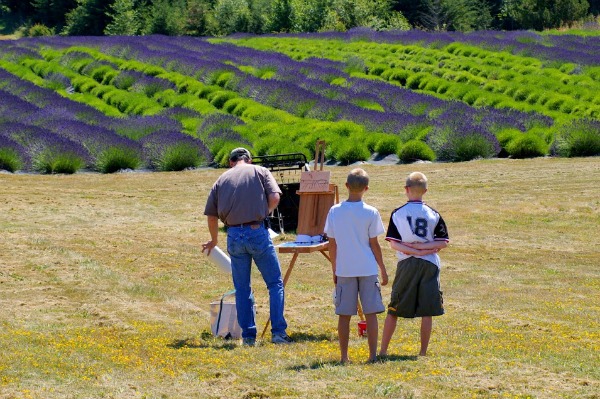
Some day, new agritourism farmers may want to venture into the world of inviting unlimited numbers of the general public to their on-farm events. And there are certainly those that started out jumping right into big, unpredictable crowds and did just fine. Larger farms with open fields and relatively safe crops such as blueberries, pumpkins and lavender often thrive -- in fact depend on -- larger crowds. When many free-roaming farm visitors show up, and every activity isn’t controlled by the farmer or her staff, pleasant surprises can appear when farm visitors spontaneously make their own entertainment. On Pelindaba Lavender Farm in Washington State, the farmers wisely invited local artists to paint their blooming fields during their festival. This on its own created a form of entertainment the other visitors loved. But unpleasant surprises can also show up, and a slower entry into agritourism may be the farmers’ best starting point..
Legal issues
The
farmer considering on-farm events needs to first check into local and
regional regulations as well as insurance issues. Even if the farm is
already operating as a crop production business, the owner needs to
check into business zoning, licensing and permits to make sure on-farm customer activities are allowed in her area and if so, what regulations
are expected to be followed. Insurance and liability may have to be
updated for the on-farm activities also. In some cases, a farmers’
current homeowner’s insurance may already cover a very small specified
number of on-farm events. But the farmer has to check the policy to make sure. And even if
so, how much and what exactly does it cover? Does it make a difference
to the policy if the farm visitors have paid to come onto the farm or if
they’re on the farm for free?
But before this starts sounding too daunting, realize that across the country, people are safely and successfully operating agritourism businesses with insurance and regulation compliance smoothly in place for them. It can and does happen all the time. There's usually just the sometimes frustrating upfront research at first to get through before settling on what works best for that particular farm and location, then simple updating now and then after that. Our insurance mini-hub may be of help. It discusses how other farmers in this situation have handled it. You may even discover that, depending on your choice of agritourism activity and the state you live in, that there will be no extra cost at all for you for liability protection as long as you put up a few signs in a specific manner. Or in the case of a B&B listed on certain platforms, liabiity insurance is a free perk if you list with them. But do the research. There are also situations where an "I'm not liable for accidents" sign will not protect from liabilty at all, and a few other measures need to be taken instead.

